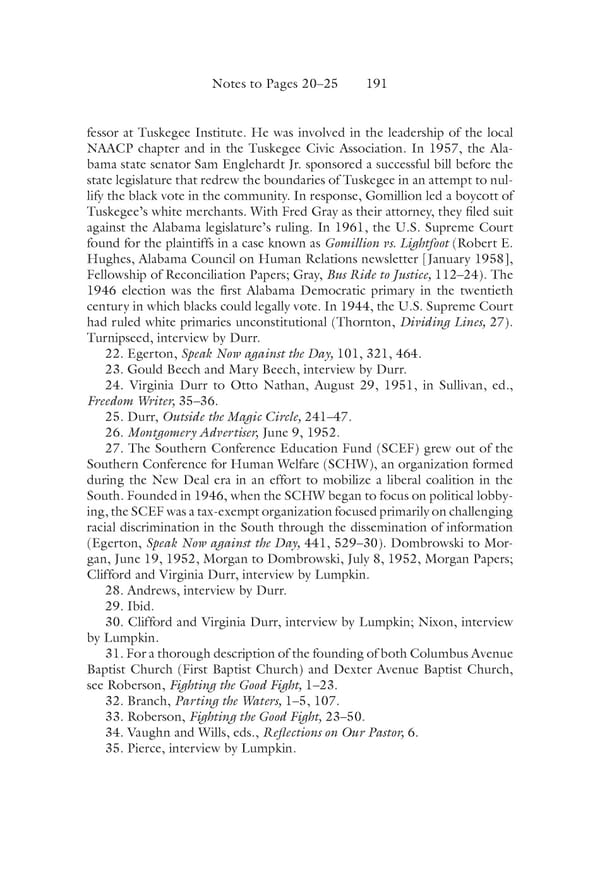Notes to Pages 20–25 191 fessor at Tuskegee Institute. He was involved in the leadership of the local NAACP chapter and in the Tuskegee Civic Association. In 1957, the Ala- bama state senator Sam Englehardt Jr. sponsored a successful bill before the state legislature that redrew the boundaries of Tuskegee in an attempt to nul- lify the black vote in the community. In response, Gomillion led a boycott of Tuskegee’s white merchants. With Fred Gray as their attorney, they filed suit against the Alabama legislature’s ruling. In 1961, the U.S. Supreme Court found for the plaintiffs in a case known as Gomillion vs. Lightfoot (Robert E. Hughes, Alabama Council on Human Relations newsletter [January 1958], Fellowship of Reconciliation Papers; Gray, Bus Ride to Justice, 112–24). The 1946 election was the first Alabama Democratic primary in the twentieth century in which blacks could legally vote. In 1944, the U.S. Supreme Court had ruled white primaries unconstitutional (Thornton, Dividing Lines, 27). Turnipseed, interview by Durr. 22. Egerton, Speak Now against the Day, 101, 321, 464. 23. Gould Beech and Mary Beech, interview by Durr. 24. Virginia Durr to Otto Nathan, August 29, 1951, in Sullivan, ed., Freedom Writer, 35–36. 25. Durr, Outside the Magic Circle, 241–47. 26. Montgomery Advertiser, June 9, 1952. 27. The Southern Conference Education Fund (SCEF) grew out of the Southern Conference for Human Welfare (SCHW), an organization formed during the New Deal era in an effort to mobilize a liberal coalition in the South. Founded in 1946, when the SCHW began to focus on political lobby- ing, the SCEF was a tax-exempt organization focused primarily on challenging racial discrimination in the South through the dissemination of information (Egerton, Speak Now against the Day, 441, 529–30). Dombrowski to Mor- gan, June 19, 1952, Morgan to Dombrowski, July 8, 1952, Morgan Papers; Clifford and Virginia Durr, interview by Lumpkin. 28. Andrews, interview by Durr. 29. Ibid. 30. Clifford and Virginia Durr, interview by Lumpkin; Nixon, interview by Lumpkin. 31. For a thorough description of the founding of both Columbus Avenue Baptist Church (First Baptist Church) and Dexter Avenue Baptist Church, see Roberson, Fighting the Good Fight, 1–23. 32. Branch, Parting the Waters, 1–5, 107. 33. Roberson, Fighting the Good Fight, 23–50. 34. Vaughn and Wills, eds., Reflections on Our Pastor, 6. 35. Pierce, interview by Lumpkin.
 Becoming King: Martin Luther King Jr. Page 211 Page 213
Becoming King: Martin Luther King Jr. Page 211 Page 213